Looking to grow grape in your backyard but can’t decide on which variety to grow?
For two years I pondered on the exact same question. While doing so I spent countless hours watching how-to grow grapes videos on Youtube. Daydreamed about having my own backyard vineyard some day.
That dream became a reality on a spring day of 2017, I transplanted my first grapevine into the garden. The label reads “Princess”, a hybrid variety from California and is a cross between crimson table grapes and a white seedless variety from the USDA-ARS Grape Research in Fresno, CA.
So, if you’re looking for white table grapes, Princess grape is one of the top choices among the bunch. Unlike wine grapes, table grapes are generally larger, seedless, with thicker pulp and thinner skins making them ideal for eating fresh, right off the vine.
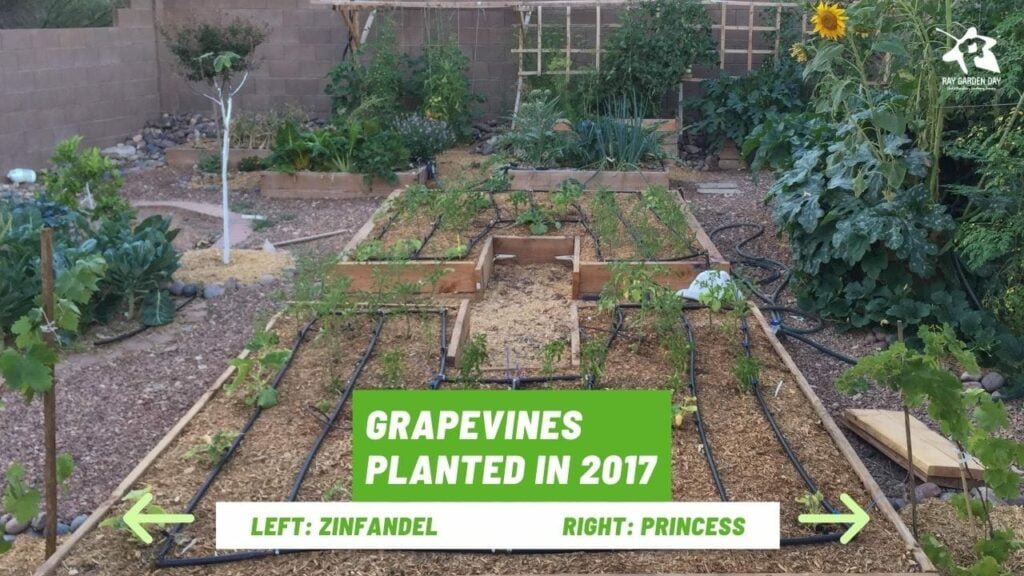
I chose a large, open, sunny spot in the garden. I recommend you do the same as grapevines need about 8 feet apart between each vine. I’m growing Princess grapevine in one corner of the 8 foot by 8 foot raised bed. On the opposite corner, I’m growing Zinfandel grapevine. This keeps them 8 ft. apart but 4 years later the Princess vine has taken over the entire area reserved for the Zinfandel. Princess is vigorous so be warned.
What climate do Princess grapes need to grow?
Long warm summers, adequate water during the growing season, and enough cold during the dormancy phase will help Princess grapevine to thrive and produce high quality berries. The optimal condition is USDA Zones between 7 to 10.
My Princess vine is growing in USA Zone 9a.
Find your USDA zone for your location and choose a grape variety according to your USDA zone. Some varieties like cooler temperatures, while others thrive in the heat.
Does soil matter? Grapevines grow in many soil types. My Princess vine is growing in alkaline soils which doesn’t drain well at all but the vine doesn’t seem to mind that.
Our soil pH is on the higher end of the spectrum, around 7.8, which is higher than the optimal range of 5.5 to 6.5 for grapevines. Yet, my Princess vine is thriving.
Princess grapevine care
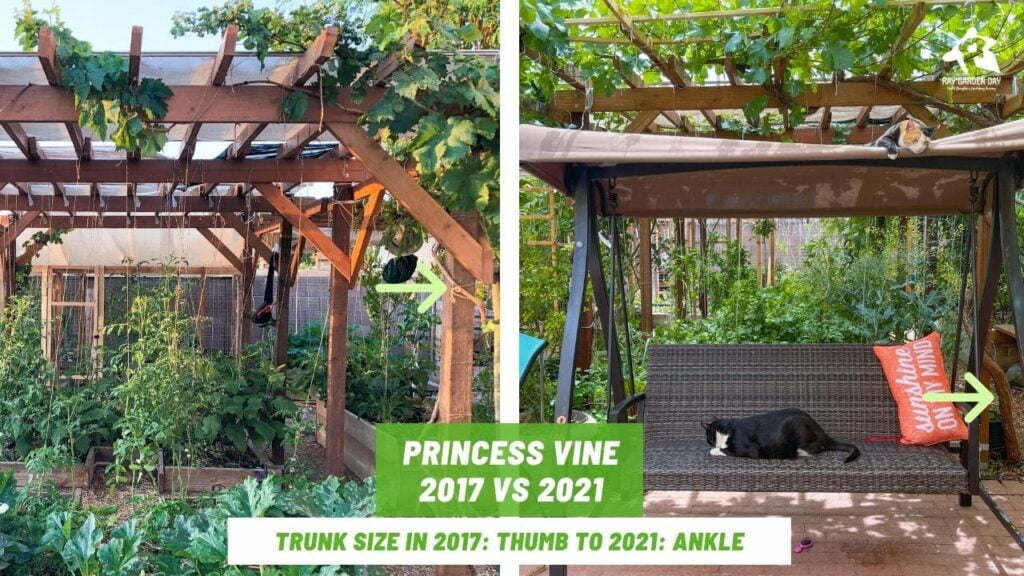
Caring for Princess grapevine is no different than most varieties of grapevines.
This cultivar is vigorous and grows faster than other grapevines I’m currently growing. So, it is a good idea to provide it a support system such as a trellis as soon as possible so you can train the vine to grow upright and over the trellis.
I built an arbor over two large raised beds and trained the grapevines up each post.
Once the trunk has reached about 8 feet, the height of the arbor, I topped it. This promotes lateral (side) branches (arms) growth which in turn are trained horizontally along the arbor.
The fruit is borne on shoots rising from one-year-old wood on the side branches.
After getting the vine to a desired height and shape I continue to prune it twice a year.
In winter during dormancy to remove old growth leaving enough old wood to ensure new growth develops in spring.
This technique is called spur pruning. I’ll blog more about grape pruning methods so be sure to check back.
Grapevines are drought tolerant especially established vines. Just like other fruit trees I’m currently growing, the Princess vine is on once a week for 1 hour drip irrigation cycle, 4 emitters.
How much you water grapevines depends, in part, on your soil and growing conditions.
The same rule applies when it comes to fertilization. Common advice out there is to use 10-10-10. But, the best thing you can do is to ask your nearest plant nurseries or garden center (not Home Depot) and see what fertilizer they use. I use a fertilizer blend from a local nursery with added micro-nutrients such as iron to make up for any deficiencies.
Powdery mildew is the most common disease affecting grapevine leaves. You can control it using neem oil spray.
Every spring I have to contend with the Grapeleaf skeletonizer. They feed on the grapevine leaves. It’s easier to get rid of them at the eggs or early hatchlings stages.
Birds and beetles love grapes. Cover them with fruit netting bags.
Yield size and taste
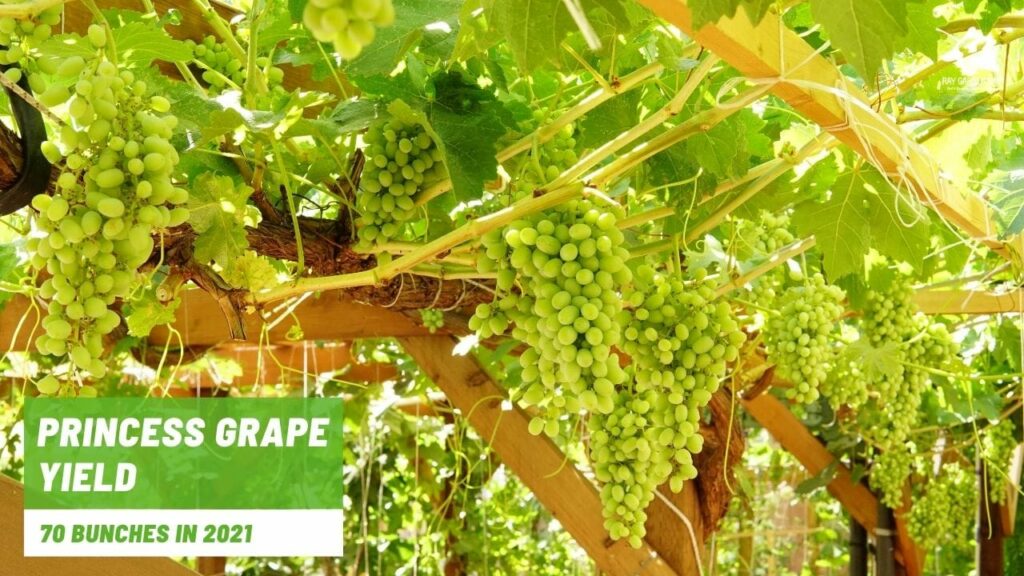
Princess grapes are medium to large in size and are round to cylindrical in shape, growing in loose, large clusters on trailing vines.
This variety reminds me of Thompson. Color about the same and matures about the same time, but the berries of Princess are almost twice as big.
The color of the berries goes from white to red in the fall.
Princess is a mild muscat flavor and sweet when the berries get full sun exposure — a pruning strategy of removing surrounding leaves and thinning out the excess clusters.
If you haven’t tasted Muscat grapes I’d say it’s the best tasting grapes I’ve had. We have a Golden Muscat grapevine planted in 2019.
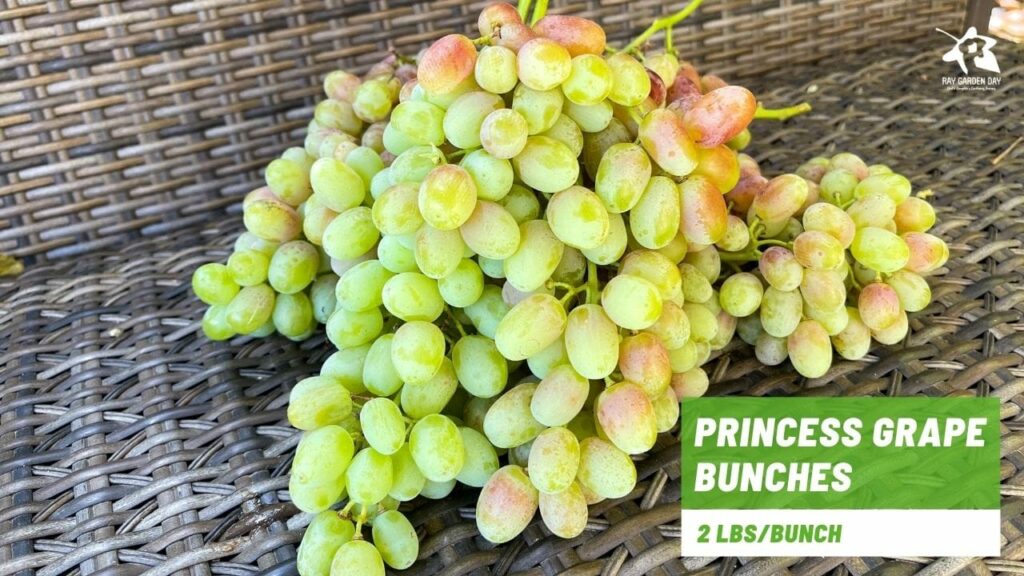
2021 was my most successful year ever at where the Princess vine almost doubled its yield, to 70 bunches. Each bunch weighs between 2-3 lbs.
Growing grape is easy and fun. My little backyard vineyard now has 11 vines containing 6 different varieties.
By far, the Princess grape has been the one I’m most proud of and I’d recommend it as your first vine to get started within your own backyard vineyard.
Princess grape FAQs
Can I grow Princess grapes at home?
Yes, Princess grapes can be grown in USDA 7-10, which means almost anywhere in the lower 48 states on the United States. If you have the space, and enjoy a bit of annual pruning, growing grapes is no more difficult than any other backyard crop.
When to plant Princess grapevine?
Transplant young grapevines in winter when they’re dormant, or in early spring. This gives them enough time to establish their roots before the hot summer weather sets in.
How long do Princess grape vines take to grow?
The Princess cultivar tends to grow rapidly from the main trunk provided any unwanted side limbs and fruits are removed. Only lateral shoots at the top wire or trellis to be left. This helps establish the main trunk to a desired height and shape in the first year.
How long do Princess grape vines take to fruit?
Generally, grapevines will produce harvestable fruit when the vine is 2 to 3 years old. The first and second year Princess grapevines will produce nothing but foliage as they try to get established.
How long does a Princess grape vine live?
Most grapevines reach the end of their viable, effective lifespan around 25 to 30 years. Once a Princess vine gets to this age the clusters of fruit become less dense and much more sparse.
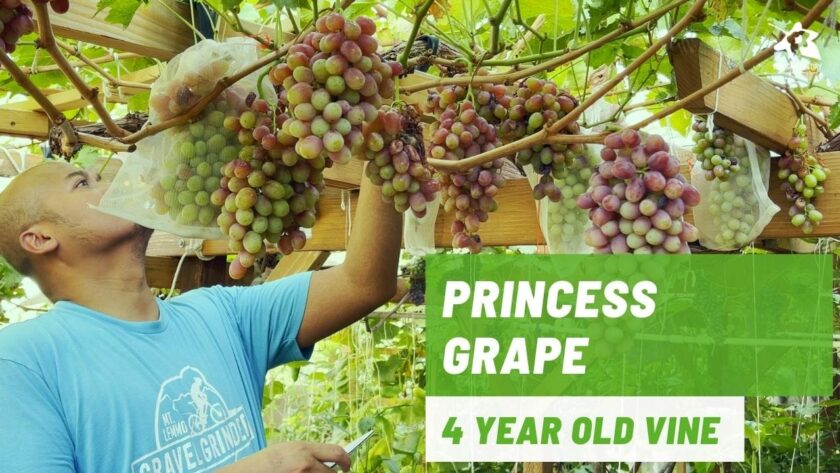




Hey Ray, I love how you grapevines grow on your trellis that you can actually sit under. It’s such a great idea. Where are the roots?? and what do you do in the meantime while you’re trying to get it to grow up? Please share,
Thanks, Kira
Hey Kira, we sit under its canopy to escape the summer heat and reach for its fruit to quench our thirst – like in the movies – this vine gives us so much. Most of the roots go deep; most are three feet deep, but grapevine roots can go more than 30 feet. This vine’s roots are under the paved area and most likely under the raised garden bed as well. As soon as it was planted, I focused on establishing the main trunk, which meant removing any new side shoots to divert its growth to the top. Once the growth had reached the desired height of our grape arbor, I topped it (cutting the top off) to divert its energy to grow three side arms to grow laterally. The side arms themselves provide the canes for foliage and fruits. This whole pruning and training system is called spur pruning, and I have a guide on it if you’re interested.
Are you growing grapes and thinking of growing some?